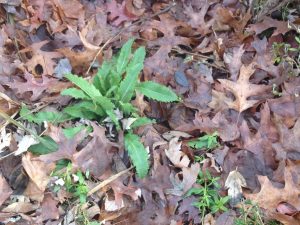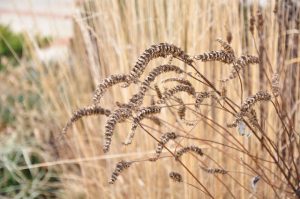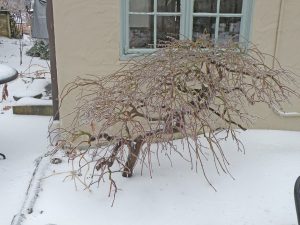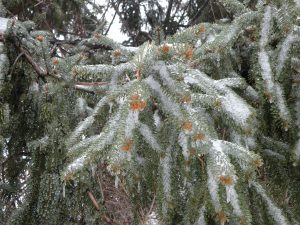The Notion of Fall Cleanup

The wispiness of Miscanthus, the bronze foliage of Iris siberica, the gray-green foliage of Lavandula, and the large panicles of Hydrangea paniculata enliven this fall and winter landscape.
Every year, I despair at the number of people who hire landscapers to blow leaves out of their beds and cut everything herbaceous (perennials and ornamental grasses) to the ground. An article written for the latest issue of Horticulture magazine by Kelley House, a Certified Professional Soil Scientist, and Kate Norvell, a Certified Professional Soil Scientist and Certified Prosfessional Agronomist explains why this is a despicable practice.
What follows is their article with a few comments added by me:
“Let It Lie: Delaying garden cleanup until spring can greatly benefit the soil”

A mix of perennials, shrubs, and ornamental grasses in my west bed in late fall
On purpose or unintentionally, many gardeners have left plants in their gardens over the winter. This is a good thing: everyone should consider doing so on a yearly basis.
Scientists, specifically agronomists and soil scientists, refer to the plant litter that remains after a harvest, as “residue”. Leaving residues in place over the winter, instead of pulling up or tilling them into the soil surface, provides numerous benefits for the soil and your garden. Plant residues reduce erosion and the loss of valuable topsoil. Residues cover soil and protect it during the non-growing season. They catch rainfall, reducing the impact that individual rain droplets have with the soil surface. Residues also slow any flow of melting snow over the soil. Both of these actions help protect the soil structure, keeping it intact for next year’s crops and gardens.
The presence of plant residues on the surface also prevents something called soil crusting. You may have seen that during a heavy rainfall, the soil won’t absorb any water. Even worse, sometimes little streams form on dry soil and then become larger streams. This carries away the soil and its important nutrients. Residues prevent these streams and their effects. (Me: Slowing down these streams is even more important on slopes where erosion is always a factor.)
Residual plant material also reduces weeds by covering and shading the soil. Weeds are often early spring germinators, and residues inhibit their growth. They limit the amount of soil that is available of weed germination and development. Residues reduce the resources and space that weed seedlings require to grow. (Me: In Spring, when I cut the stalks of perennials and reseeding annuals to their base, I do not put those stalks into yard waste bags. Instead, I break up or cut the stalks into two-inch lengths and lay them on the ground between the plants. They will eventually decompose, returning their nutrients to the soil.)
Plant residues provide shade, regulating soil temperature. This keeps soils cooler during the non-growing season to the early part of the next growing season. Cooler soil temperatures provide more suitable conditions for soil microbes. Microbes are necessary for maintaining a productive soil for crop and plant growth growth. Cooler soil temperatures also aid in the retention of soil moisture, which in turn is favorable for seed germination in the spring…. In sum, residues create microhabitats of moist, even-temperature, microbe-rich soil to the benefit of plant seeds and seedlings.
Lastly, plant residues provide a source of organic matter for the soil. Organic matter is essential to soil health. It helps create an environment supportive of growth. Organic matter provides an energy source for soil microbial populations, which results in faster decomposition rates, releasing essential nutrients for crops and garden plants. Soil organic matter also helps maintain good structure of the soil itself. This further reduces erosion and improves water infiltration and soil aeration.

Fallen leaves raked into bed
(Me: Leaves should also be considered as residues. Blow or rake them off your lawns but into your beds where they will decompose over the winter. If you want the leaves in the beds to decompose even more quickly, cover them with an inch of compost, leaf humus, or any other organic material. If you have a shredding mower, you could leave the residue on the lawn because it will decompose quickly.)

Agastache ‘Blue Fortune’ seedheads (Sam Bahr-University of Maryland)

The architecture of this dormant Japanese maple is best seen during the winter.

Picea abies with snow
To me, a garden that appears to have nothing in it during the winter is very depressing. I love looking at the stalks and seedheads of the perennials and ornamental grasses as well as the varying colors and structures of my conifers and the architecture of deciduous trees and shrubs. When covered with snow, and I have a feeling that this is going to be a very snowy winter, the garden becomes a series of sculptures. Don’t you want to love your garden during the winter?


4 Comments